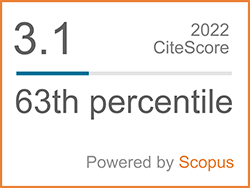Optimization for Epoxidation of Malaysian Jatropha curcas Oil Based Trimethylolpropane Ester Biolubricant
Abstract
Keywords
[1] N. Salih and J. Salimon, “A review on ecofriendly green biolubricants from renewable and sustainable plant oil sources,” Biointerface Research in Applied Chemistry, vol. 11, pp. 13303– 13327, Feb. 2021.
[2] N. M. Nor, N. Salih, and J. Salimon, “Optimization of the ring opening of epoxidized palm oil using D-optimal design,” Asian Journal of Chemistry, vol. 33, pp. 67–75, Jan. 2021.
[3] A. M. Bong, N. M. Kor, and P. T. Ndifon, “Cameroon green energy potentials: Field survey of production, physico-chemical analyses of palm kernel oil for industrial applications,” Green and Sustainable Chemistry, vol. 10, pp. 57–71, Jan. 2020.
[4] Y. N. Lye, N. Salih, and J. Salimon, “Optimization of partial epoxidation on Jatropha curcas oil based methyl linoleate using urea-hydrogen peroxide and methyltrioxorhenium catalyst,” Applied Science and Engineering Progress, vol. 14, no. 1, pp. 89–99, 2021, doi: 10.14416/j. asep.2020.12.006.
[5] C. J. Reeves, A. Siddaiah, and P. L. Menezes, “A Review on the science and technology of natural and synthetic biolubricants,” Journal of Bio- and Tribo-Corrosion, vol. 3, pp. 11, Mar. 2017, doi: 10.1007/s40735-016-0069-5.
[6] O. R. Turco, R. Tesser, R. Vitiello, V. Russo, S. Andini, and M. D. Serio, “Synthesis of biolubricant basestocks from epoxidized soybean,” Catalysts, vol. 7, p. 309, Oct. 2017.
[7] J. M. Encinar, S. N. Delgado, N. Sánchez, and J. Félix González, “Biolubricants from rapeseed and castor oil transesterification by using titanium isopropoxide as a catalyst: Production and characterization,” Catalysts, vol. 10, p. 366, Mar. 2020.
[8] S. Bashiri, B. Ghobadian, M. D. Soufi, and S. Gorjian, “Chemical modification of sunflower waste cooking oil for biolubricant production through epoxidation reaction,” Materials Science for Energy Technologies, vol. 4, pp. 119–127, May 2021.
[9] N. M. Nor and J. Salimon, “Preparation of epoxidized palm oil by using performic acid,” Malaysian Journal of Chemistry, vol. 21, pp. 11– 19, Dec. 2019.
[10] A. A. Japir, N. Salih, and J. Salimon, “Synthesis and characterization of biodegradable palm palmitic acid based bioplastic,” Turkish Journal of Chemistry, vol. 45, pp. 585–599, June 2021.
[11] T. Y. Woma, S. A. Lawal, A. S. Abdulrahman, and M. A. Olutoye, “Nigeria Jatropha oil as suitable basestock for biolubricant production,” Jurnal Tribologi, vol. 23, pp. 97–112, Dec. 2019.
[12] G. Anand, J. Yick, and S. N. Kabir, “Rheological and tribological properties of Jatropha curcas biolubricants at various blend concentrations,” Biofuels, to be published, 2021, doi : 10.1080/ 17597269.2020.1833410.
[13] N. H. Arbain and J. Salimon, “The effects of various acid catalyst on the esterification of Jatropha curcas oil based trimethylolpropane ester as biolubricant base stock”, E-Journal of Chemistry, vol. 8, pp. 33–40, Apr. 2011.
[14] N. M. Nor, N. Salih, and J. Salimon, “Chemically modified Jatropha curcas oil for biolubricant applications,” Hemijska Industrija, vol. 75, pp. 117–128, Mar. 2021.
[15] M. Bahadi, N. Salih, and J. Salimon, “Synthesis and characterization of green biodegradable palm oleic acid based polyester,” Biointerface Research in Applied Chemistry, vol. 11, pp. 14359– 14371, Mar. 2021.
[16] R. Abdullah and A. A. Ahmad, “Optimization of linoleic acid monoepoxidation condition from Malaysian Jatropha curcas using central composite design (CCD),” Applied Mechanics and Materials, vol. 754–755, pp. 1107–1112, Apr. 2015.
[17] M. S. Shehu, S. I. Lamido, and A. U. Alhassan, “Optimization of double transesterification for biolubricant synthesis from Jatropha oil,” International Advanced Research Journal in Science, Engineering and Technology, vol. 6, pp. 23–30, May 2019.
[18] J. Salimon and W. A. Ahmed, “Physicochemical characteristics of tropical Jatropha curcas seed oil,” Sains Malaysiana, vol. 41, pp. 313–317, Mar. 2012.
[19] J. Salimon, N. Salih, and E. Yousif, “Synthesis, characterization and physicochemical properties of oleic acid ether derivatives as biolubricant basestocks,” Journal of Oleo Science, vol. 60, pp. 613–618, Dec. 2011.
[20] N. Salih, J. Salimon, and E. Yousif, “Synthesis of oleic acid-based esters as potential basestock for biolubricant production,” Turkish Journal of Engineering and Environmental Sciences, vol. 35, pp. 115–123, Jan. 2011.
[21] N. Salih and J. Salimon, “A review on new trends, challenges and prospects of ecofriendly friendly green food-grade biolubricants,” Biointerface Research in Applied Chemistry, vol. 12, pp. 1185–1207, Jan. 2022.
[22] M. Bahadi, N. Salih, and J. Salimon, “D-Optimal design optimization for the separation of oleic acid from Malaysian high free fatty acid crude palm oil fatty acids mixture using urea complex fractionation,” Applied Science and Engineering Progress, vol. 14, no. 2, pp. 175–186, 2021, doi: 10.14416/j.asep.2021.03.004.
[23] W. A. Ahmed, N. Salih, and J. Salimon, “Lubricity, tribological and rheological properties of green ester oil prepared from bio-based azelaic acid,” Asian Journal of Chemistry, vol. 33, pp. 1363– 1369, Jun. 2021.
[24] T. M. Panchal, A. Patel, D. D. Chauhan, M. T. Jigar, and V. Patel, “A methodological review on bio-lubricants from vegetable oil based resources,” Renewable and Sustainable Energy Reviews, vol. 70, pp. 65–70, Apr. 2017.
[25] S. Samidin, N. Salih, and J. Salimon, “Synthesis and characterization of trimethylolpropane based esters as green biolubricant basestock,” Biointerface Research in Applied Chemistry, vol. 11, pp. 13638–13651, Feb. 2021.
[26] N. Al-Arafi, N. Salih, and J. Salimon, “Synthesis, characterization and optimization of oleyl oleate wax ester using ionic liquid catalysts,” Indonesian Journal of Chemistry, vol. 21, pp. 659–668, Apr. 2021.
[27] J. Salimon, W. A. Ahmed, N. Salih, M. A Yarmo, and D. Derawi, “Lubricity and tribological properties of dicarboxylic acid and oleyl alcohol based esters,” Sains Malaysiana, vol. 44, pp. 405– 412, Mar. 2015.
[28] A. Z. Syahir, N. W. M. Zulkifli, H. H. Masjuki, M. A. Kalam, A. Alabdulkarem, M. Gulzar, L. S. Khuong, and M. H. Harith, “A review on biobased lubricants and their applications,” Journal of Cleaner Production, vol. 168, pp. 997–1016, Dec. 2017.
[29] J. Tang, J. Zhang, J. Lu, J. Huang, F. Zhang, Y. Hu, C. Liu, R. An, H. Miao, Y. Chen, T. Huang, and Y. Zhou, “Preparation and properties of plant-oilbased epoxy acrylate-like resins for UV-curable coatings,” Polymers, vol. 12, p. 2165, Sep. 2020.
[30] N. T. Thuy, V. M. Duc, and N. T. Liem, “The epoxidized vietnam rubber seed oil as a secondary plasticizer/thermal stabilizer in PVC processing,” International Journal of Polymer Science, vol. 2021, pp. 1–8, Apr. 2021.
[31] S. Sharma, H. Tyagi, N. Kumar, and V. Yadav, “Comparative tribiological investigation of mahua oil and its chemically modified derivatives,” SAE International Journal of Fuels and Lubricants, vol. 7, pp. 360–365, Apr. 2014.
[32] R. Rafiee-Moghaddam, J. Salimon, M. D. Jelas-Haron, H. Jahangirian, M. H. S. Ismail, S. Hosseini, and M. Rezayi, “Lipase epoxidation optimizing of Jatropha curcas oil using perlauric acid,” Digest Journal of Nanomaterials and Biostructures, vol. 9, pp. 1159–1169, Jul. 2014.
[33] A. Sammaiah, K. V. Padmaja, and R. B. N. Prasad, “Synthesis of epoxy Jatropha oil and its evaluation for lubricant properties,” Journal of Oleo Science, vol. 63, pp. 637–643, May 2014.
[34] M. C. Menkiti, O. Ocheje, and C. M. Agu, “Production of environmentally adapted lubricant basestock from Jatropha curcas specie seed oil,” International Journal of Industrial Chemistry, vol. 8, pp. 133– 144, Jun. 2017.
[35] E. J. Parente, J. P. C. Marques, I. C. Rios, J. A. Cecilia, E. Rodríguez-Castellón, F. M. T. Luna, and C. L. Cavalcante, “Production of biolubricants from soybean oil: Studies for an integrated process with the current biodiesel industry,” Chemical Engineering Research and Design, vol. 165, pp. 456–466, Jan. 2021.
[36] K. Nwosu-Obieogu, F. O. Aguele, and L. Chiemenem, “Optimization on rubber seed oil epoxidation process parameters using response surface methodology,” Iranian Journal of Chemistry and Chemical Engineering, Article in press, doi: 10.30492/IJCCE.2020.40345
[37] Z. Cao, F. Gao, J. Zhao, X. Wei, Q. Cheng, J. Zhong, C. Lin, J. Shu, C. Fu, and L. Shen, “Bio-based coating materials derived from acetoacetylated soybean oil and aromatic dicarboxaldehydes,” Polymers, vol. 11, p. 1809, Nov. 2019.
[38] E. Milchert and A. Smagowicz, “The influence of reaction parameters on the epoxidation of rapeseed oil with peracetic acid,” Journal of the American Oil Chemists' Society, vol. 86, pp. 1227–1233, Dec. 2009.
[39] A. Lopera-Valle, J. V. Caputo, R. Leão, D. Sauvageau, S. M. Luz, and A. Elias, “Influence of epoxidized canola oil (eCO) and cellulose nanocrystals (CNCs) on the mechanical and thermal properties of polyhydroxybutyrate (PHB)-poly(lactic acid) (PLA) blends,” Polymers, vol. 11, p. 933, May 2019.
[40] L. K. Hong, R. M. Yusop, N. Salih, and J. Salimon, “Optimization of the in situ epoxidation of linoleic acid of Jatropha curcas oil with performic acid,” Malaysian Journal of Analytical Sciences, vol. 19, pp. 144–154, Jan. 2015.
[41] Y. Yildiz, R. Karadag, and S. Jackson, “Iodine value in partially hydrogenated castor oil (Ricinus oil) as determined by advances in clinical toxicology iodine value in partially hydrogenated castor oil (Ricinus oil) as determined by AOCS Official Method Cd 1-25 ( Wijs ’ Method ),” Journal of Advances in Clinical Toxicology, vol. 5, pp. 1–6, Jul. 2020.
[42] D. L. Pavia, G. M. Lampman, G. S. Kriz, and J. R.Vyvyan, Introduction to Spectroscopy, 5th ed. Delhi, India: Cengage Learning, 2015.
DOI: 10.14416/j.asep.2021.10.009
Refbacks
- There are currently no refbacks.






.png)



